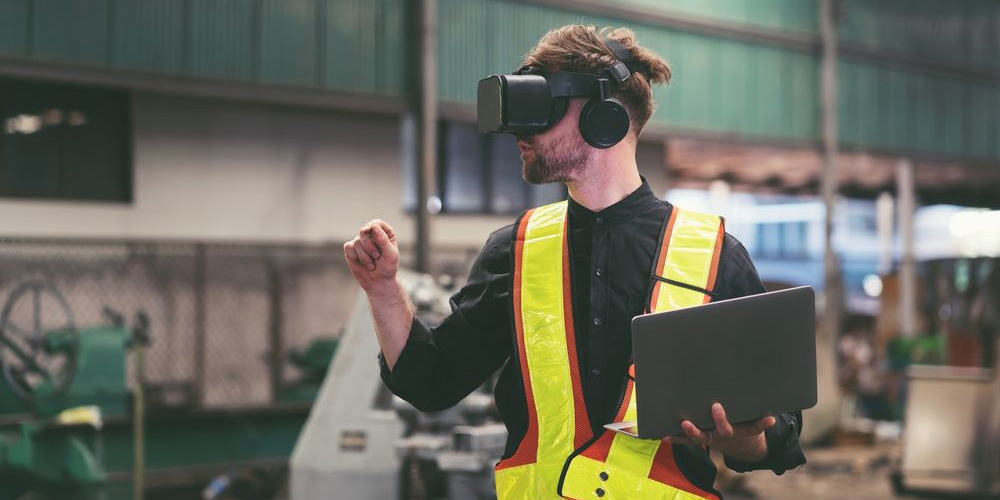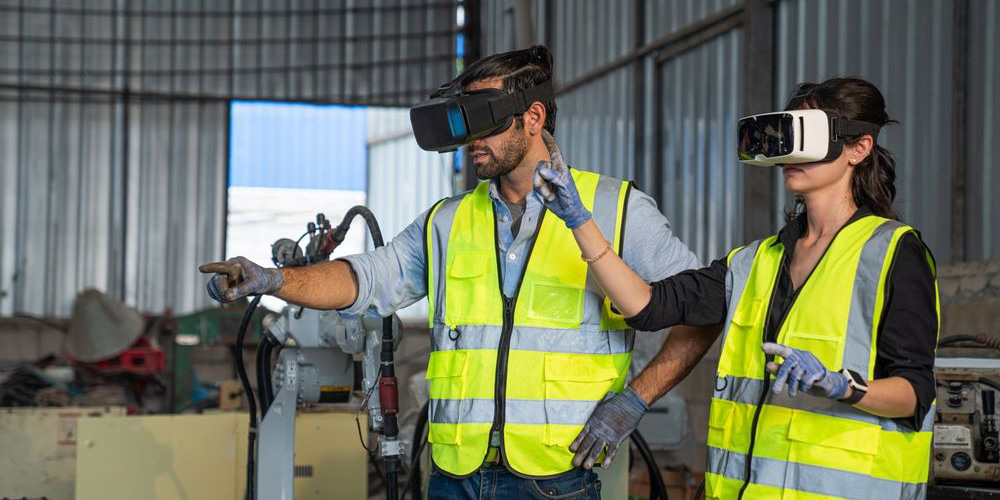VR for Mechatronics Engineering: Experiments in Safe Virtual Environment

Mechatronics engineering is a multidisciplinary field that combines mechanical and electrical engineering with elements of computer science and control engineering.
As technology continues to advance, so does the way we educate future engineers. One of the most innovative tools to emerge in recent years is Virtual Reality (VR).
VR technology has found its place in education, particularly in the field of mechatronics engineering.
In this blog post, we'll explore the potential of VR for mechatronics engineering education and how it's transforming the way students learn and conduct experiments in a safe virtual environment.
The Role of VR for Mechatronics Engineering
Mechatronics engineering revolves around the seamless integration of mechanical and electrical systems to create innovative and highly efficient solutions.
It's a fascinating field that demands a deep understanding of both hardware and software, often involving students in hands-on experimentation and real-world application.
Additionally, the advancement of technology has led to the development of mechatronics virtual labs, providing a simulated environment for students to further enhance their skills and knowledge in this interdisciplinary field.
But, the integration of Virtual Reality (VR) technology has evolved as a transformative force in mechatronics education.
Wait! VR is not just another gadget. Instead, the immersive nature of VR is at the heart of its potential in this field.
VR has opened up new avenues for hands-on learning, offering students the unique opportunity to interact with complex mechatronic systems within the safe confines of a virtual environment.
With VR, the students are immersed in a world where the boundaries between the physical and digital blur. This means that the students are provided with a firsthand encounter with the concepts they are studying.
This immersive quality of VR is what sets it apart and elevates mechatronics education to a whole new level.
With VR engineering, students are no longer passive observers. They're active participants, able to manipulate objects, observe their behavior, and make real-time adjustments.
It's a hands-on experience like no other, offering students a profound understanding of mechatronic concepts that textbooks alone can't provide.
Benefits of Using VR for Mechatronics Education
After putting on the VR headset, the students can step into the world where learning isn’t confined to the traditional classroom settings.
The virtual environment becomes your laboratory, your workshop, and your playground, all rolled into one.
It's a space where mistakes are not costly, where experiments are limitless, and where curiosity knows no bounds.
Some of the benefits of using VR in mechatronics education are explained below-
✔️ Safety First
Mechatronics involves working with physical systems that may pose safety risks. VR offers a safe environment for students to experiment without the danger of accidents.
For instance, students can explore electrical circuits, robotics, and control systems without the risk of electrical shocks or physical harm.
✔️ Cost-Effective
Building and maintaining physical prototypes and labs can be costly. VR eliminates the need for expensive equipment and physical setups. This cost-effectiveness makes mechatronics education more accessible to a wider range of students and institutions.
✔️ Accessibility
With VR, students can access mechatronics virtual lab experiments from anywhere, reducing geographical limitations.
This accessibility is especially valuable for remote learning and for students who may not have access to advanced lab facilities.
✔️ Interactivity
VR enhances the learning experience by providing an interactive environment. Students can manipulate objects, observe their behavior, and make real-time adjustments, fostering a deeper understanding of mechatronic concepts.
✔️ Scalability
Instructors can create and customize VR modules to cater to various skill levels and specific learning objectives. This scalability ensures that students receive tailored education.
"Embark on a journey into the future of mechatronics engineering! Dive into immersive VR experiences for safe and groundbreaking learning."
Applications of VR in Mechatronics Engineering

In the ever-evolving field of mechatronics engineering, the applications of VR are as diverse as the field itself. Let's delve deeper into some of these transformative applications:
✔️ Understanding Complex Systems
VR opens a gateway to understanding intricate mechatronic systems like never before.
Within the virtual reality world, the students can dissect a robotic arm, explore the intricacies of an automated manufacturing line, or even take a virtual ride in an autonomous vehicle.
It not only makes complex concepts accessible but also interactive.
It has taken hands-on learning to a whole new level. Students can virtually manipulate components, observe their interactions, and gain invaluable insights into the functioning and control of these systems.
Amazing. Right?
✔️ Exploring Fluid Mechanics
Now, let's shift our focus to the world of fluid mechanics.
It's a topic that often appears as a daunting challenge for many budding mechatronics engineers. But fear not, because VR is here to demystify the secrets of fluid dynamics.
Through VR simulations, students can step into the world of fluid dynamics, where they can visualize fluid flow, explore turbulence, and delve into thermodynamics.
And the best part is that all this will happen without the need for complicated and costly physical setups.
Well, without a doubt, VR is revolutionary for mechatronics engineers dealing with hydraulic and pneumatic systems.
VR to understand fluid mechanics, allows them to grasp fluid mechanics concepts in a hands-on, intuitive manner, making it easier to design and optimize mechatronic systems involving fluids.
✔️ Electrical Circuit Simulation
Gone are the days of staring at circuit diagrams on a chalkboard or computer screen.
VR has now brought circuits to life!
VR in electrical engineering has become a powerful ally in understanding and mastering the complexities of electrical circuits. Now students can create and manipulate electrical circuits in a dynamic, three-dimensional space.
They can assemble components like resistors, capacitors, and transistors with a simple wave of your virtual hand.
Not only this, but with VR, they can experiment with different configurations, test out circuit designs, and witness electrical principles come to life right before their eyes.
It's an immersive journey through the world of electrons and currents, making electrical engineering concepts more tangible and relatable than ever.
 Get the App from Meta Store: Download Now
Get the App from Meta Store: Download Now
The Future of VR in Mechatronics Education
Looking ahead to the future of VR in mechatronics education, it's truly an exciting journey that's just getting started.
As technology keeps progressing, we can look forward to some remarkable developments in VR tailored specifically to the needs of mechatronics students.
Let's dive into these potential advancements in a more conversational tone:
✔️ Realistic Haptic Feedback
Imagine a virtual world where you're not just seeing and hearing things but also feeling them. That's what realistic haptic feedback in future VR systems could offer.
It's like reaching out and touching virtual objects, making the learning experience incredibly immersive. You'll feel the texture of a robot's surface or the resistance in a virtual gear mechanism.
It's the next level of sensory engagement that can deepen your understanding of mechatronics concepts.
✔️ Collaborative Learning
Learning doesn't have to be a solitary experience, even in the virtual domain.
In the future, VR can bring students from different corners of the world together in one virtual classroom.
Here is a glimpse of the future- You and your peers, each wearing a VR headset, all working on the same mechatronics project as if you were in the same physical space.
This collaborative learning environment will foster teamwork and communication skills, preparing students for the real-world collaborative nature of mechatronics engineering.
✔️ AI-Powered Learning
Artificial intelligence (AI) isn't just for science fiction anymore. In the context of VR mechatronics education, AI can become your personalized mentor.
Imagine navigating through a virtual experiment, and as you go, an AI system is right there with you, offering guidance tailored to your unique learning style and pace.
It adapts to your strengths and areas where you need more help, making your learning journey smoother and more efficient.
It's like having a patient, all-knowing tutor by your side whenever you need it.
Conclusion
In conclusion, it's truly amazing how VR is transforming the landscape of mechatronics engineering education. This technology is like a breath of fresh air, bringing a whole new dimension to students learning and experimenting.
What's particularly striking is how it addresses some of the critical challenges faced in mechatronics education like safety and cost factors.
Whether you're into VR for mechanical engineering or diving into the world of VR in electrical engineering, one thing's certain this technology holds immense potential to shape the future of mechatronics education.
It's a thrilling journey, and we're only just beginning to scratch the surface of what VR can do in this field.
.png)
.png)



